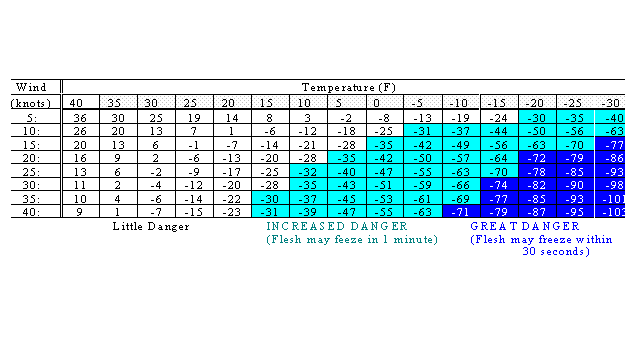
Thermometers are one way to measure temperature. The more expensive the instrument the more precise the temperature measurement. Our bodies are not very good at making precise measurements of temperature, but they are very sensitive to how fast we cool-down or heat-up.
If you attend a football game on a cool autumn night and you have a choice of sitting on a wooden bench or a metal bench, you will probably pick the wooden bench. The benches will have the same temperature but the metal one will feel colder because it has a higher heat-conductivity, causing your butt to cool down faster. On a cold, windy day you try to keep yourself warm by seeking shelter from the wind. Heat transfer by conduction is the reason it feels colder in the wind. You are probably jumping up and down and claiming that air is a poor conductor, that's why its placed between pieces of glass in storm windows. Still air is a poor conductor, but moving air is not!
To explain the wind-chill factor, let's first consider a calm day with an air temperature of 32F (0C). Conduction transfers heat from your skin to the surrounding air molecules. These molecules, because of random motions, will slowly diffuse away from your skin, taking some of your body heat with them. Since diffusion is a slow process you do not lose much heat by conduction on a calm day. Once the wind begins to blow, your skin comes into contact with more molecules, giving up heat to each one by conduction. The number of molecules colliding with your face increases as the wind speed increases. The rate at which your face loses heat increases, and you cool down faster. The wind-chill accounts for the increased loss of heat by the movement of the air. The wind-chill, expressed in degrees, translates your body's heat losses under the current temperature and wind conditions, to the air temperature under calm conditions that would produce equivalent heat losses. The following table gives the wind-chill temperature as a function of current temperature and wind speed.

Frostbite occurs when your skin cools down below the freezing point. Frostbite usually occurs at your body's extremities, fingers, toes and ears. Which brings us to a final factor that determines how fast an object will cool down -- the ratio of an object's surface area to its volume. Increasing this ratio causes the object to cool down faster.
If you lose heat faster than your body can produce it, your internal body temperature will fall. In an attempt to keep warm, for example by shivering, the body loses energy. Hypothermia occurs when your body temperature drops to a point where metabolic activities cannot operate normally. The first signs of hypothermia are confusion and a loss of judgment, followed by a stupor and possibly death. To avoid hypothermia you should be aware of what the wind-chill is and try to stay out of the wind and stay dry. When someone has been overexposed to the cold, get them into warm dry clothes, have them drink hot beverages, do not give them alcohol, give them food and allow them to rest.
The above discussion dealt with the air temperature being colder than the body temperature 98.6F (37C). During summer there are many regions in the US, and the world, where the temperature gets into the 100F range. Because the air is warmer, heat is transferred from the air to your body, causing your body temperature to increase. When exposed to hot conditions, your body cools down by sweating and evaporation. The amount of vapor in the atmosphere determines the rate of evaporation.